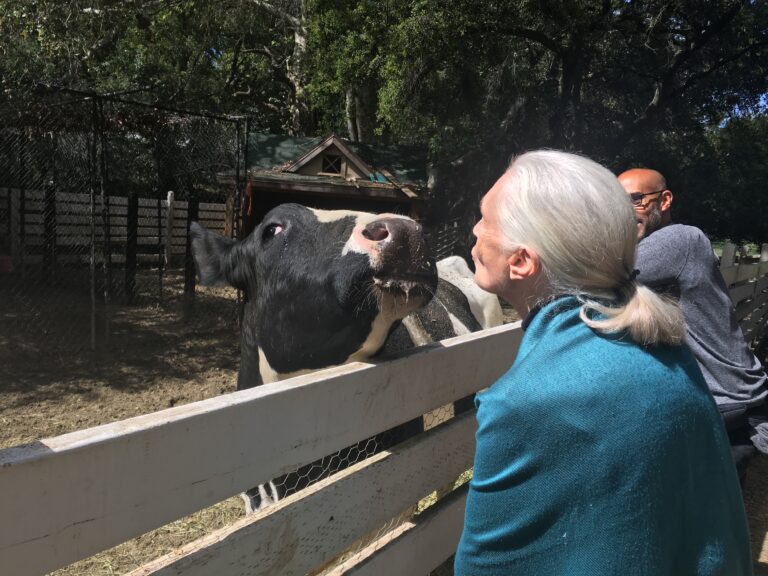I first met cows when I was 5 years old, on a farm belonging to my father’s family. I always loved all animals, and I remember I was so excited to see the cows, and their calves out in a big field, the mothers grazing while their calves played and frolicked. 10 years later, when I was helping on a farm in my school holidays, I learned to milk. This was in the days when the cows were milked in the morning, let out of the barn to graze all day, then came in from the fields to be milked in the late afternoon. (I remember, some time later, watching in horror as the cows’ udders were inserted into suction tubes for mechanical milking in a factory farm). I grew to love the cows I milked. I knew them as individuals, each with her own personality. And on that farm the calves stayed with their mothers at least until they were 5 months old. This was before the modern factory farms were thought of.
Brave people, working undercover, have observed and taken videos of how cows are so often treated today. The factory farms typically are nothing more than inhumane cow concentration camps. Most cows never get outside, and are forced to stand in small and often filthy spaces. They are artificially inseminated once a year. This is painful for the cow, and agonizing for the bull (as his sperm is usually collected by electro ejaculation). On some farms the babies are allowed to suckle to start the milk flowing before being dragged away to be raised in bleak, sterile, solitary stalls on soy milk. So their mother’s milk, that she produced for her baby, can be sold for us. The separation from the mother is heartrending. Once I heard a mother and her new born calf crying out to each other, desperate and helpless, throughout the night. What makes it worse is that, when cows are allowed to keep their calves to adulthood, mother and child form really close bonds. They are social animals and form close bonds within a herd, especially between family members.
Bull calves are either raised for veal and killed when they are just a few weeks old, or raised for beef. Those calves are often kept singly in small pens, on metal mesh. The only exercise for these social youngsters is the few steps they take to be fed. When they are older they may be crowded into yards often with no shelter from the elements. I saw one such place: there were so many animals in the small yard that they could hardly move, and as it had been raining they were almost up to their knees in mud polluted with excrement. Their misery and hopelessness kept me awake. When it is time for slaughter they are forced into trucks, so closely packed together they cannot move, and often driven for miles without food and water. I can never forget looking into the eyes of the cattle in such a truck. I was in a car that for some time was driving parallel to the truck and I saw confusion and fear. What new horror was happening to these innocent beings who had harmed no one? Again I could not sleep.
And the final horror – the slaughter. I have only seen videos, taken by brave undercover heroes, of groups forced into the narrow passage at the end of which they are subjected to stunning. But in their terror, hearing the anguished calls around them, some jerk their head and so avoided the stun gun. The rules prohibit killing conscious animals, but in the rush to kill the appropriate number of cows per hour they are almost always sent on to their cruel fate, alive and conscious. I was in tears as I heard their screams of fear and pain.
Fortunately more and more sanctuaries are appearing for animals rescued from factory farms. I was lucky enough to see three dairy cows, no longer productive, that had been rescued from slaughter. As they were let out into their field they began to run, their hugely enlarged udders, now empty, wildly swinging from side to side as they threw up their heels in an ecstasy of freedom. I had a friend who had rescued one calf, and as he grew he bonded with her, and learned to play fetch exactly like a dog. She would throw the ball down a slope and the young bull would give chase, bellowing with excitement, then return the ball, butting it with his nose so that the game could be repeated – again and again. And apparently this is not uncommon. In other words, cows are playful when given the chance. Another cow laid her head on the shoulder of a friend when he played the guitar. And it is known that cows will approach to listen when classical music is played near or in their field.
The lack of understanding among the general public is disturbing, because if more people knew what went on in the factory farms they would be less willing to eat the flesh or drink the milk resulting from what amounts to something akin to torture. I became a vegetarian when I learned about factory farms. After reading Peter Singer’s “Animal Liberation” I remember looking at a piece of meat on my plate and thinking “This symbolizes Fear! Pain! Death!” I did not eat it, or any meat since. And it was the same with milk and cheese once I learned about the horror of dairy farms.
Only when people understand the facts of industrial animal farming and move towards a plant based diet, only when there is wider acceptance that farm animals are sentient and often sapient, can we hope to end these barbaric practices.
This statement from Dr. Jane Goodall, DBE was originally written for the Cows Foundation.



